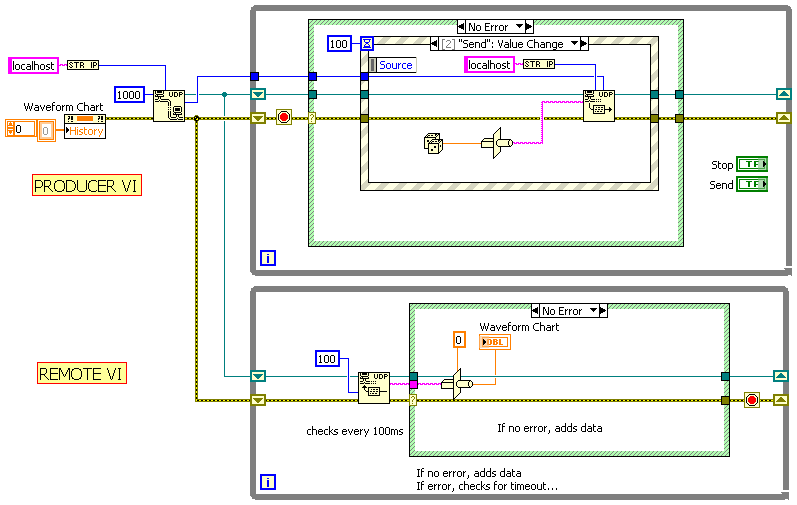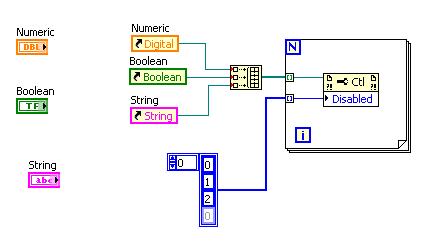-
Posts
1,211 -
Joined
-
Last visited
-
Days Won
48
Content Type
Profiles
Forums
Downloads
Gallery
Posts posted by Francois Normandin
-
-
It's only one VI, but it simulates a producer and a consumer...
Download File:post-10515-1216411135.vi (LV 8.5)
CCT rules!!!
-
-
QUOTE (Louis Manfredi @ Jul 17 2008, 08:41 AM)
I was browsing a physics forum this afternoon and stumbled on the question as to what could compose a force field like in Star Trek. An interesting hypothesis is proposed... Could that be the Chi substance?
-
QUOTE (Omar Mussa @ Jul 18 2008, 02:49 PM)
Is it possible to launch multiple instances of an EXE built by LabVIEW App Builder?I do it to test my tcpip communications, so I'd say yes. The same EXE copied in two separate directories can be launched at the same time and run separately as long as they are not using the same port or other potentially shared resource.
-
-
As far as I'm concerned, I accept your apologies. :beer:
a) I didn't open your VI because I thought your problem was clearly stated... That being said, I'll have a look at it now to see if I got my answer satisfactorily posted.
b) A tip for future questions: I don't usually look at posts that contain "Help", "plz" (please), "Quick" or "Urgent". I might not be the only one... It's very often school homework questions and since I am working a full time job, I choose the topics I answer accordingly.
EDIT:
-
Use the ActiveCell property + CellBackgroundColor property.
Check the help and you'll find a table of the expected results.
Row, Column, Result
–1, –2, Selects the headers of all columns.
-
QUOTE (Dirk J. @ Jul 17 2008, 03:03 AM)
And maybe something like "each class is allowed a constructor and destructor in which getters and setters are allowed".Although I tend to agree with the observation, I can see another possible hack with this: What if you create an object and destroy it right away just to get access to the get/set features of that class? Defeats the purpose of the exercise.
-
Many reasons why it won't work. And also some interogation marks in my head too...
1- Your example won't work because your data is not linearly independant. Your matrix is singular (determinant = 0) because in your simulation, all your data are integer multiples (only loop number changes). You produce the equivalent of this:
1 2 3 | 1
2 4 6 | 2
3 6 9 | 3
which is equivalent after reduction to:
1 2 3 | 1
0 0 0 | 0
0 0 0 | 0
This system cannot be solved because the solving algorithm relies on inverting the matrix. By definition, singular matrices cannot be inverted.
Try generating your simulated data with some noise, using a random number to throw it out of its perfect line... This way, you'll generate data that doesn't algebraicly cancel each other out. Also, get some code out of the big loop, as it is not necessary to calculate the same thing 1000 times when it can be replaced by a constant value.
2- However, this thread here talks of the same problem... and no answer could be found other than starting the algorithm close to the expected values of a1, a2, a3... I ran a simple fit and got good results, except that the error message didn't disappear until I started the initial parameters at different values (a1 =! a2 =! a3) ... I don't know why I had the singular matrix error message when a1 = a2 = a3.
As far as I know,
1 2 3 | 0.2
1 3 4 | 0.2
2 6 7 | 0.2
is not a singular matrix...
Anyway, starting with {0.19, 0.20, 0.21} got rid of the error.
3- See also this thread on ni forums.
So, my simple example worked out but when I ran your code with some modifications (random data), I couldn't get it to fit your data... We'll have to find out the reason, because I'll have a hard time sleeping in the coming days.
 Let us know of your progress. I hope my explanation will help you out. Now is my time to go to sleep... :clock: If I dream of anything useful, I'll let you know!
Let us know of your progress. I hope my explanation will help you out. Now is my time to go to sleep... :clock: If I dream of anything useful, I'll let you know! PS. Sorry I didn't use the express VI like in your example. I tend to avoid them as I test solutions. They're completely equivalent to the code you had... I don't mean thta as an editorial on Express VI use.

-
QUOTE (crelf @ Jul 14 2008, 03:14 PM)
Did you practice your accent http://en.wikipedia.org/wiki/Pain_au_chocolat' rel='nofollow' target="_blank">here?

Although I prefer calling it "chocolatine"... Puts the emphasis where it should be.
-
The simplest I see would be to instruct your firewall to block outbound access to LabVIEW.exe. (but that's rather harsh, considering you might need that connection sometime in the future)
There could be an LabVIEW.ini key or NI registry edit that would do it, but that I am not able to help
 .
. -
QUOTE (tcplomp @ Jun 13 2008, 01:35 AM)
I recently opened my LabVIEW.ini file and found these two keys:
[LabVIEW]
RecentFiles.projectPathList=
RecentFiles.pathList=
Are the private methods just calls of Configuration Files VIs? Or does it take the info from registry or some other place?
-
-
I have a colleague who immigrated from Singapore... he played that exact same trick on our group at the first presentation he gave us. Let's call it a weird "collective" experience!

-
-
Kilometers of wires is cool, but it is too dependant on screen size...
That might trigger an habit of buying larger LCDs right before yearly evaluation period.

-
-
-
Perhaps you could propose an OpenG "Initialize nD Array". :thumbup:
-
-
Contact your local NI representative and look at this evaluation kit.
NI has support for ARM7, ARM9 & CortexM3.
-
QUOTE (lalo22 @ Jul 8 2008, 02:45 PM)
http://sine.ni.com/apps/utf8/nipc.get_came...C&asid=1102
If your camera is not listed there, maybe you'd be lucky and your camera supplier has some LabVIEW drivers (dll wrapper)... Call them, you never know.
-
My advice: don't play in the dark... it got me a bad headache!

-
QUOTE (JRTritsch @ Jul 7 2008, 10:26 AM)
Disclaimer - I am new to labviewI can't seem to speed up the data acquisition and I am not sure where the bottleneck is. It is (what I think) a fairly simple VI created to read two voltages and output another. I am only able to get recordings at maybe 2-3Hz; which is not very good. Previously the same system was operating on Labview 3 on a apple II taking data at something like 40Khz and signal averaging - which is where I would like to eventually get.
Which hardware are you using?








UDP sender and reciver
in Remote Control, Monitoring and the Internet
Posted
UDP over LAN restricts you to 8192 bytes per send (1024 x 8 bits). For larger datasets, you'll need to send in many packets and find a way for your receivers to "know" how to concatenate the pieces together. Use some wrapper brackets or tags for sending large datasets.
QUOTE
How will you broadcast if not through a LAN? Do you have an other mean of connecting your clients to the server?
A UDP is nice to avoid management of connections, but you can never be sure that the client received the data, or even how many clients are connected. For diagnostic purposes, I would tend to agree with NevilleD and use TCP.